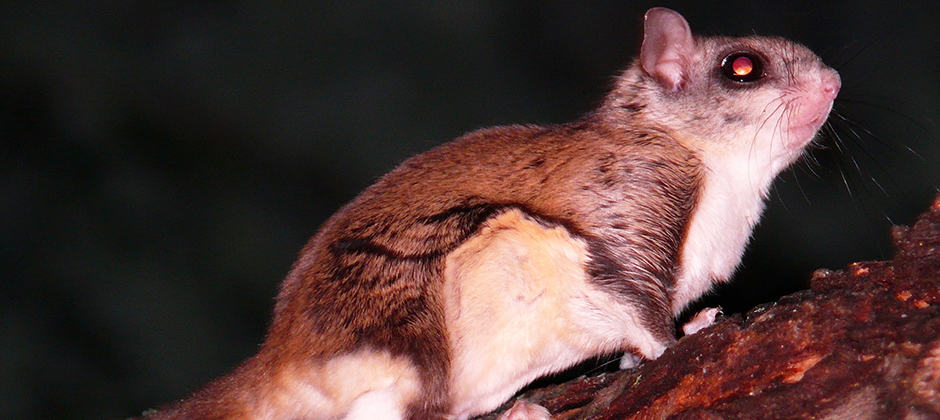Share this article
TWS2020: How does fragmentation affect flying squirrels?
With their habitat broken up by farms and other land uses, southern flying squirrels have smaller densities in the Midwest, researchers found.
“They are isolated by a highly fragmented system,” said Katherine Rexroad, a graduate student at Western Illinois University and TWS member who presented her ongoing research at the 2020 TWS Virtual Conference. “They’re isolated, because they have the Mississippi River on one side and agriculture on the other side.”
But since the arboreal species glides rather than flies, she said, the squirrels (Glaucomys volans) can’t cross the river or traverse agricultural land.
Researchers in her lab had already determined that home range sizes for these flying squirrels are much smaller than those in the East, where they have more contiguous forest. Rexroad also knew that male and female home range sizes didn’t differ in the Midwest, which is unique. In other areas, males tend to have larger ranges due to their reproductive strategies. “We were not observing that here. It may be just because it’s a small space comparatively,” she said.
Rexroad and her colleagues set out to get a better idea of flying squirrel densities in the fragmented area. She expanded trapping areas by using grids and increasing distance between traps. Previously, her colleagues placed traps in transects 15 meters apart. She widened it to 50 meters. “Expanding the area, we can use these tools to give us a more accurate, complete picture of squirrels in this region and how they’re using the space and, of course, their density estimate,” she said.
In addition, she is looking at parasite levels and testosterone levels to determine if those factors impacted their space use.

Researcher Katherine Rexroad holds a southern flying squirrel. Credit: Courtesy Katherine Rexroad
During the winters of 2015 and 2016, Rexroad captured flying squirrels from nest boxes and tagged them before releasing them. In the following summers, they trapped them using Sherman traps. “Honestly, that’s one of my favorite parts,” she said. “It’s so exciting when you peak into a trap and it’s a flying squirrel and not a mouse or something else.”
The team placed their data into capture data into models called oSCR (spatial capture recapture models), a package created by Rexroad’s advisor Robert Klaver, taking into account spatial information about where the traps were placed. With the models, Rexroad and her colleagues estimated as few as 1.64 squirrels per hectare in the winter and as few as .18 per hectare in the summer. Densities appear so much greater in the winter time, because the squirrels are communally nesting to conserve heat, Rexroad said. They spread out in the summer to utilize more resources and rear young. Overall, those numbers were lower than estimates throughout the eastern U.S.
Rexrod hopes her ongoing research can give her a better understanding about how fragmentation affects southern flying squirrel density. “People are not necessarily concerned about southern flying squirrels in this region,” she said, but they are a species of concern in some areas.
Her research methods might provide more accurate density estimates for flying squirrels in the East, she said, and they might also help estimate populations of northern flying squirrels (Glaucomys sabrinus), which are more threatened. “People are concerned about northern flying squirrels that face threats of climate change, parasites and habitat fragmentation,” she said. “This is a great way to test the model and math and use it for other arboreal mammals.”
This research was presented at TWS’ 2020 Virtual Conference. Conference attendees can continue to visit the virtual conference and review Rexroad’s paper for six months following the live event. Click here to learn about how to take part in upcoming conferences.
Header Image:
Southern flying squirrels have smaller densities in the Midwest, where their habitat is fragmented.
Credit:
Credit: Ken Thomas








